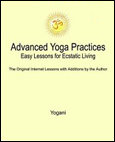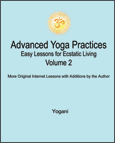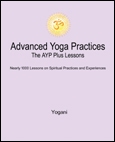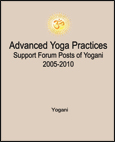|
Public Home | Plus Home | Main Lessons | Tantra Lessons | Public Forum | Plus Forum | Downloads | Books Topic Paths | Search | Training-Retreats | Testimonials | Survey | Interviews | MultiMedia | Contact | Donate |
|
Advanced Yoga Practices Note: For the Original Internet Lessons with additions, see the AYP Easy Lessons Books. For the Expanded and Interactive Internet Lessons, AYP Online Books, Audiobooks and more, see AYP Plus. Lesson 327 - The Evolutionary Stages of Mind (Audio)
AYP Plus Additions:
From: Yogani New Visitors: It is recommended you read from the beginning of the web archive, as previous lessons are prerequisite to this one. The first lesson is, "Why This Discussion?"
The styles can vary widely, from prescribing complete conscious engagement in the minutest details of the identification of awareness with objects of perception (sometimes called mindfulness), to letting go of life altogether, including all seeking. Whatever the teaching may be, it will always reflect the experience of the particular teacher who is transmitting the knowledge. There will be a bias, and the teaching may or may not resonate with all students who come to study that approach. It is up to the student to find a teaching that does resonate. All self-inquiry teachings have one thing in common they seek to dissolve the identification of awareness with objects of perception, including all thoughts, feelings and objects of the world. The goal of self-inquiry is to eliminate the bondage of "me and mine," as fabricated by the mind. We all come at different stages of readiness to undertake this unwinding of the ego, as it has been called. In truth, it will not make any sense at all to most of us, until we have tasted the peace of inner silence within us. Then we know there is something more to us than the many props we have used to create our identity in the world the identity that we all know will end as the body decays and dies. As soon as we have glimpsed the eternal within ourselves, it is a whole new ball game. There is something more than the limited and ever-grasping ego. To know it we must make a journey that encompasses heart, mind and body. Nothing less will do. Times are changing. Now it is time for spiritual teachings to serve the people, instead of the other way around. And in order to do so, the teachings must be open, flexible, and, most importantly, effective. To be effective, such teachings must be capable of addressing every student at every level of readiness. If the student has the desire to grow and is willing to make a commitment of time and some discipline, then the teaching must be able to deliver viable means, or it will be in need of some improvement. This is okay. If teachings are flexible, they will serve the people where they are, and evolve as the people evolve. Self-inquiry is a particularly tricky one for application for different levels of students. In the case of AYP, we begin with daily deep meditation, which will cultivate inner silence. Additional methods of yoga are be added as appropriate. A foundational knowledge of self-inquiry is also necessary. First, it is good to know that in our essential nature we are unbounded pure bliss consciousness, and that all we are doing in practices is unfolding what we already are in our daily life. It is also good to know that this will lead to many practical benefits. So, it is a worthwhile endeavor to be on the path. Next, it is also good to know that there is a natural progression in our spiritual unfoldment which occurs over time, usually over a long time, except in the rare cases of people who are born near enlightenment. In spite of what we may have heard, enlightenment is not an overnight event for most people. There is no getting around this, because each of us must go through a process of inner purification and opening, and it takes time, even with the best of teachings. Along the way, there are grades and stages, and the journey never ends, even for those who are very advanced. Perhaps especially for them, because they become much more aware of the wider need for rising inner silence in the community, world and beyond, and find themselves on the front line of that great endeavor. We all help as we can, and the enlightened can help so much more. The more we can do, the more we will be called to do. For the individual, there is a progression of integrated practices that is mapped out in a step-by-step way throughout these lessons for cultivating the necessary purification and opening. For self-inquiry, there is a progression also. Not that it is required for everyone to go through a progression of self-inquiry methods. One may not even use structured self-inquiry methods at all, and still be going through the process of self-inquiry based on the natural emergence of inner silence and the increasingly clear perceptions of Self (witness) in relation to the objects of experience. Regardless of structured self-inquiry methods, or the lack of them, some recognizable stages of mind will evolve, and it can save time and some confusion to be aware of these, particularly for those who have a tendency to try and run to the end before covering the beginning or the middle. The beginning and the middle can be just as fulfilling as the end if we are reasonably well in touch with where we are on our path. It does not have to be so mysterious. With some basic knowledge, we will do much better, and not be so much exposed to the hazards of taking blind leaps led by our over-eager mind (more on the "pitfalls of the mind" in an upcoming lesson). Assuming one is engaged in daily deep meditation, here are five stages of mind that self-inquiry may play itself upon as we move along in our development:
While progress on the road to enlightenment may be erratic, difficult or non-existent when engaged in self-inquiry as a stand-alone approach, it is quite a different story when self-inquiry is used in concert with a path based on an integration of tried and true yoga methods. The cultivation of inner silence (the witness) in deep meditation assures that our perception will be expanding from within over time, and this provides for an increasingly fertile field for the process of self-inquiry to occur. So too, does our experience in daily samyama practice cultivate our ability to release in stillness and live more from the level of our abiding inner silence. As purification and opening proceed within us, our self-inquiry methods will change and refine over time, as we migrate from pre-witnessing to witnessing, discrimination, dispassion and unity. The steady emergence of inner silence and our ability to release our intentions and perceptions within it are the dynamics behind the progression of self-inquiry from non-relational to relational, until the experiencer and the experience have merged to become One, self-sufficient, active in the world, and free of the bondage of identification and suffering. Pre-Witnessing How meaningful is self-inquiry of the absolute (non-duality) kind when we are still in the pre-witnessing stage of mind? This is when all things are still considered primarily on the level of thinking and logic. In this state, what does it mean to us when we hear, "All this you see here in the world is illusion, and you are the reality behind it." We might have some inspiration, a desire may be kindled to know more, to be more. Hopefully. But the more we think about it, the more layers we will create around that essential desire to know the truth. How many times will we have to repeat the question "Who am I?" before we will have a glimmer of who and what we really are? And how many books will we have to read? This is why we call pre-witnessing the stage of inspiration and building castles in the air. Not much more than this can happen until we move to the next stage. With suitable inspiration, we will be compelled to take action beyond pounding the idea against the infinite with our tiny brain! The mind can only run in circles for so long before we realize that we must add something else to the mix. Once we are inspired to uncover the truth, it is important to take action, intelligent action. Self-inquiry purists will say, "Take no action. Do nothing. Just be!" Well, we can attempt to do that for a very long time in pre-witnessing mode. No doubt we can develop some witness quality by working on just being. But there is a much faster way. If we commit to take action using all the tools that are available to us, we can travel very quickly along the road of realizing what we already are our inner most Self. With deep meditation and a full battery of supporting practices we will move surely into the witnessing stage. Witnessing As mentioned before, the witnessing stage is a whole new ball game. It should be pointed out that there is witnessing and there is witnessing. There is a continuum of development as witnessing emerges. It begins as a passive inner condition perceived as a separation from the events going on around us, often first noticed during the occurrence of dynamic events. Everyone has had the experience of time standing still when a dynamic event occurred, like a car crash, explosion or other sudden change in our physical environment. When the witness begins to emerge, ordinary events are gradually experienced more in this way also. As witnessing continues to advance, our body, thoughts and feelings become objects of perception that are separate from our sense of self, our witness. This is an important development. Before the witness has developed to the point where our thoughts and feelings become objects of perception, self-inquiry will be mostly non-relational, meaning not fully connected with who we are pure consciousness. The dawn of the witness sets the stage for real self-inquiry, and an ongoing change in our life experience, for this is when the process can move beyond ideas to the direct experience. And the direct experience is beyond all experience. In the initial witness condition, we are experiencing, but we are not the experience. We are beyond it, seeing from the point of view of separate pure awareness. There are a few more steps beyond the emergence of the witness that we must go through. It is not enough to be strongly established in inner silence, seeing the changing world as separate from ourselves. We must do something with it to move it forward. Evolution compels us to do so. With a little nudging, it happens naturally enough. This is where self-inquiry can have its greatest impact on our over all path to enlightenment, because we are able to make conscious choices based in our stillness. We see our thoughts, feelings and perceptions of the world for what they are, without being entirely identified with them. We are then able to engage in a way that is liberating rather than binding, both for ourselves and for others. Other yoga practices are an aid to this process, such as samyama, spinal breathing pranayama, and additional practices that cultivate ecstatic conductivity (kundalini awakening) in the body. As we become more established in both inner silence and ecstatic conductivity, we experience refinements in perception and the movement of dynamic stillness into our thought processes. These developments support steadily increasing effectiveness in relational self-inquiry. Discrimination When we think of discrimination, the normal interpretation is that we are choosing between this or that thing choosing between this or that idea. Non-relational self-inquiry is like that, choosing between things, ideas, and ways we imagine we would like for life to be. This kind of discrimination is circular, goes nowhere fast, and may go nowhere for a long time. Even choosing not to think is a gigantic task when undertaken non-relationally, without the witness present to support our endeavor. With the rising presence of the witness, the entire dynamic of self-inquiry changes. Then we are choosing between that which is object (things, ideas, emotions) and that which is subject (witness,Self). And that kind of choosing is not a doing at all. It is a letting go. A surrender, even while we are being active in the world. We all know what we want. We want to know the truth. We want to be happy. We want to be free. Since childhood we have been told that the truth will set us free from the burdens of this life. So we want That. As the witness becomes more and more abiding and quietly observing every thought and feeling, we come to know ourselves as That, unshaken and independent of all of our experiences, including our own thoughts then we are finally in the position to make choices that will unwind the habitual identification with experiences and the dream we have been in up until now. It is a new perspective from which we can clearly see what is real and what is not. At the same time, it is both as profound and as simple as directly perceiving what is eternal and what is not. And we can discriminate accordingly, making logical choices that are grounded in stillness, unwinding the lingering habit of the mind to identify itself with the objects of experience, both outside and inside us. In the language of advaita (non-duality), it is called neti neti, which means not this and not this. When the witness is sufficiently present for relational self-inquiry to occur in the form of discrimination, then neti neti becomes a reality. We directly perceive what is true and what is not, and we can easily choose. Before then, neti neti will be an exercise of the intellect, and can be as ineffective and exhausting as any other non-relational self-inquiry. We will know the witness is dawning in earnest when discrimination becomes easier. It is a telltale sign. A certain excitement comes with the realization that we have arrived at the point of being able to choose with certainty that which is real over that which is not. There can even be an enthusiasm to the exclusion of all else, and we have to guard against throwing out the practices that have brought us to this point. There can be a tendency to plant our flag on the notion that we are That, and fixate on the idea that all we have to do from then on is hang onto That. If this happens, it can be slipping into non-relational self-inquiry again. It can happen to advanced practitioners. Much better we should continue with the practices that brought us to this point and strengthen the presence of the witness beyond all tendencies we might have to imagine that we have attained anything. Even the most advanced practitioners must guard against falling into non-relational self-inquiry. Certainly we can take giant leaps toward realization when our ability has risen to clearly discriminate between objects (external and internal) and the subject (the witness our Self). It is prime time for self-inquiry. But it will not be the only thing going on, assuming we have been wise and continue with our daily routine of yoga practices. All methods combined will assure our rapid forward progress. Self-inquiry is useful, but it cannot be trusted to operate alone. Certainly not at the discrimination stage, or at any prior stage. There will come a time when discrimination begins to give way to something else. It is the letting go of the need to make choices anymore. The subject (witness) becomes so well established that choices no longer need to be made. We just are, and we can allow everything in our field of awareness to just be, even as we are interacting normally in every day living. We call this the dispassion stage. It is the stage of being completely unruffled by anything that happens inside or outside us. Dispassion The condition of dispassion is one of the primary goals of self-inquiry. Those who are very enthusiastic and dedicated to self-inquiry are very passionate about developing dispassion. This is non-relational self-inquiry, of course. We all have to begin somewhere. We can't begin at the end, though we may certainly be passionate about the ideal we have chosen, and that serves a purpose. It is our bhakti (devotion to our chosen ideal). Dispassion is not a doing at all, and is beyond self-inquiry itself. It isn't even a letting go, for it is beyond choice. Dispassion is a state of being. It is the subject (the witness, our sense of Self) developed through an integration of practices to the point where all the objects of experience are taken in stride, without identification. This applies to events, relationships, and all that is going on in the body, heart and mind. Is dispassion a state of indifference, a state of uncaring? Does it mean we do not act or react in the world? It does not mean that. It is just the opposite. Much of spiritual development is paradoxical, with less becoming much more. The gradual emergence of dispassion means we are becoming more free to act for the good of all. Inner silence will move to do this through us more and more, the further we travel along the path. It is the paradox of enlightenment. The more we have gone beyond, the more engaged we will become for the benefit of others. This is the nature of divine consciousness. We really have to give credit where credit is due. Deep meditation (if we are doing it) is the primary cultivator of dispassion, because dispassion is an advanced stage of the witness. A stand-alone path of self-inquiry can lead to dispassion also, but it is rare. To succeed, self-inquiry must ascend to the level of meditation, the transcendence of all objects of attention. If self-inquiry is done like this over time, then the witness will dawn and, in more time, there will be dispassion. It is a difficult path, because it lacks a structured and efficient routine of practice. The concept of practice itself may be lacking. Self-inquiry of the stand-alone variety will be about constantly remembering to release all objects of perception, including all thoughts, feelings and perceptions of external objects. When self-inquiry becomes a deeply ingrained habit, then that will be a kind of ongoing meditation. How an approach like this will fit into daily life is another question, since it requires ongoing self-inquiry to be incorporated into every nook and cranny of our daily life. This may not be practical for someone with a family and career. There can be direct conflicts, particularly before the witness has dawned. On the other hand, if deep meditation and other sitting practices are undertaken in a structured twice-daily routine, and life is lived normally, the witness will be coming up naturally as a support to family and career, and also as a support to undertake self-inquiry in a way that does not disrupt the normal flow of life. Deep meditation provides the witness, and self-inquiry provides the perspective in a way that is not replacing everyday life and activities, but enhancing them. Dispassion is at home in the marketplace, as well as in the remote retreat. It is all the same. The combination of daily deep meditation and gradually emerging self-inquiry provides flexibility for living, and is a much faster path as well. Unity No one knows what the true nature of existence is outside the realm of time and space. Yet, oddly enough, we can experience it directly. The reason we say "We cannot know" is because the reality we are all able to experience through deep meditation and self-inquiry is outside the field of knowing. It is That, and thousands of volumes have been written attempting to describe That. In the end, the best we can do is say, "I am That." Then we can carry on with the many descriptions of That pure bliss consciousness, void, Tao, God, Allah It doesn't really matter what we call it. That is as good a word as any, and we are That. All that exists is That. If it sounds a little impersonal, it is not intended to be. For That is the source of all love, compassion, goodness, creativity and happiness in the world. That illuminates us with these divine qualities, and is the source of all good deeds. There is a misunderstanding that has been perpetuated by some teachers the premise that becoming That is the only thing of importance and nothing here on earth matters at all. In fact, according to this premise, nothing here on earth exists. In a philosophical sense this may be true. We learned it in high school quantum physics, yes? Yet, when taken on the level of intellect, it is one of the biggest traps for getting stuck in non-relational self-inquiry. There is the idea that it matters not one bit what becomes of this earth or the multitude of life that is on it. There is a distinction between one who is truly enlightened and one who has created a division between themselves and the rest of the world through non-relational self-inquiry, enforced by a rigid intellectual view. With clear relational self-inquiry based in stillness, we can reject this out of hand. Neti neti! The enlightened one will be he or she who remains engaged for the benefit of all as That. Advancement on the path to enlightenment brings with it the perception that we can only be free when all are free, for we are One with all who are suffering. The image of the lone sage on the mountaintop, indifferent to the travails of the world, is fiction. If a sage is not engaged in some way for the benefit of others, their condition will be in question. True enlightenment is the spontaneous outpouring of divine love, which is working constantly to uplift everyone. The sage becomes a willing and wide open channel for That, which does nothing even while doing everything. So, while yoga and self-inquiry are often viewed as a going beyond, never to return, it is not so. We can never leave what is here and now, for it is what we are in our own Self. The journey of yoga, and of self-inquiry, is a journey beyond all that is, ending in a return and full engagement for the betterment of humankind a journey from here to here. This is the highest knowledge, and its highest manifestation in this world. "I am That. You are That. All this is That." It is an unending outpouring of divine love, whose fundamental nature and ultimate fruition is life everywhere residing in the Oneness of unity. It has always been That and will always be That. The witness and self-inquiry lead to direct realization of That. The guru is in you. Discuss this Lesson in the AYP Plus Support Forum Note: For detailed discussion on the practical utilization of self-inquiry, and how to avoid ineffective uses of self-inquiry, see the Self-Inquiry book and the Liberation book, and AYP Plus. |
|
|
|
Join the Mail List:
AYP Retreats
eBooks - PDF, EPUB
FREE eBooks with
SAVE with Bundled
|

























